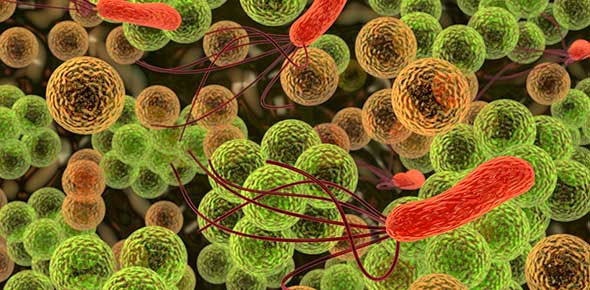Related Flashcards
Related Topics
Cards In This Set
| Front | Back |
|
Are viruses smaller and simpler than bacteria or prokaryotes? ***
|
Yes!
|
|
What makes viruses so "simple"? What do / don't they have?
|
They lack the structures and metabolic machinery that is usually found in cells, no response to stimuli, do not have many normal cell structures (cell membrane) ;
They are only genes surrounded by a protein coat |
|
Are viruses simple living organisms or nonliving? Explain both sides of the argument.
|
Because viruses are capable of causing disease, and can spread between organisms, people though they were simple living forms
But, they cannot reproduce or carry out metabolic activities outside of a host cell, and they dissemble during reproductive cycle. (Some say they live "a kind borrowed life") |
|
What came first: the detection of the virus or the sight of a virus? ***
|
The detection, long before they could see them (they are small!!)
|
|
How were viruses first detected? Describe the experiments.
|
A German scientist (Mayer) rubs the sap of an infected tobacco plant (discoloration,growth deficiency) onto healthy plant, but couldn't find the microbe with a microscope; Hypothesis: Cause was from an "unusually small bacteria"
Tested and proven by Russian biologist (Ivanowsky), who filtered (bacterium-trapping) the infected sap, which still produced the disease |
|
Ivanoosky thought maybe the bacteria made a toxin that was small enough to fit through the filter and cause the disease. Why was this ruled out later on?
|
A Dutch botanist (Beijerinck) did an experiment:
He used the filtered sap to infect a healthy plant. But And then used the latter plant's sap and found that it could aldo infect another healthy plant. He did this several times. Results: Ability of plant to cause disease was undiluted after several transfers. The infectious agent in the filtered sap could reproduce (not a characteristic of toxins) |
|
How small are viruses (actual number)? Compared to a ribosome? ***
|
Around 20nm (smaller tha nribosome) - 300nm in diameter (still barely visible in light microscope)
|
|
Some viruses can be crystallized. What does this infer?
|
Not even the simplest cells can aggregate into crystals. This is another point to the argument that a virus is not a cell.
|
|
How is the virus genome different from the conventional genome?
|
Their genome may consist of double-stranded DNA, single-stranded DNA, double-stranded RNA, or single-stranded
RNA, depending on the kind of virus (DNA or RNA virus) It is either a SINGLE linear or circular molecule of nucleic acid (some may have multiple molecules) |
|
How many genes are in each virus genome? Compare this to bacteria genome ***
|
Smallest virus - four genes
Largest virus - several hundred to a thousand Bacteria - (200 - several thousand) |
|
What is a capsid? Different shapes? What are they made out of?
|
The protein shell enclosing the viral genome.
Shapes - rod-shaped, polyhedral, or complex (T4) Composition - a large number of protein subunits called capsomers (not much variety in these subunits per capsid) |
|
What are the different kinds of microbes?
|
Prokaryotic microbes - bacteria, archaea
Eukaryotic microbes - protists, some fungi (yeasts) Viruses |
|
How has the leading cause of death changed from 1900 to 2000?
|
1900 - leading cause was Influenza and pneumonia
2000 - leading cause is heart disease |
|
Who is Wendell Stanley ***
|
After Beijernck, he researched on the virus causing the mosaic disease in tobacco plants led to the isolation of a nucleoprotein which displayed tobacco mosaic virus activity.
He won a Nobel Prize for isolation of the TMV nucleoprotein particle |
|
What is the shape of the Tobacco Mosaic virus?
|
Rod-shaped (Helical virus), a thousand capsomeres arranged in a helix
|





